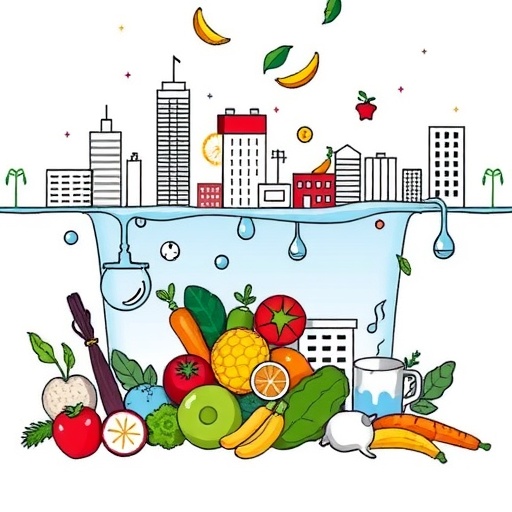Urban centers worldwide grapple with the dual challenges of managing solid waste and wastewater, typically addressing these critical streams through distinct and largely uncoordinated systems. This traditional dichotomy, while functional, neglects the potential efficiencies and environmental benefits that could be achieved by integrating these waste streams, particularly when considering the resource recovery opportunities presented by organic waste. Recent research exposes this gap and pioneers an innovative solution to unify food waste and wastewater treatment, leveraging mechanistic understanding and data-driven models to pave pathways for sustainable urban waste management.
At the heart of this breakthrough lies the urban biowaste flux model, a sophisticated analytical framework developed to simulate and quantify the flows of organic materials, energy consumption, financial costs, and greenhouse gas emissions intrinsic to city-scale waste processing. By incorporating detailed mechanistic bioprocesses alongside life-cycle environmental assessments, this model transcends traditional compartmentalized approaches, enabling a holistic evaluation of integrated food waste and wastewater treatment strategies tailored to specific urban contexts.
The model’s construction is grounded in an extensive dataset capturing the intricacies of waste composition, treatment technologies, operational parameters, and tariff structures unique to different cities. This provides an unprecedented level of resolution and accuracy in forecasting outcomes of treatment scenarios, crucial for policymakers and urban planners who seek to optimize infrastructure investments and regulatory frameworks in pursuit of sustainability goals.
Validation of the urban biowaste flux model was rigorously executed using extensive real-world data from Hong Kong, a dense metropolitan hub with complex waste streams and existing separation practices. This validation confirmed the model’s predictive robustness, engendering confidence in its applicability for diverse urban settings with varying waste characteristics and infrastructural capacities.
Deploying the model across a dataset encompassing 28 major global cities revealed revealing patterns in cost dynamics and environmental impacts associated with diverting food waste into sewage systems. Notably, the analysis uncovered a linear relationship between net treatment costs and the moisture content of food waste, a biochemical parameter with profound implications for process efficiency and resource recovery.
Intriguingly, this relationship highlighted a critical moisture threshold—approximately 50 kilograms per capita annually—beyond which integrating food waste into sewage streams becomes economically favorable. This insight disrupts conventional wisdom on waste management economics and signals a paradigm shift in designing urban infrastructure to synergistically harness organic waste valorization.
By optimizing treatment strategies, cities were shown to significantly reduce overall greenhouse gas emissions, with potential cuts reaching as high as 69% compared to existing systems where solid and liquid wastes are managed separately. Such emissions reductions align with global climate mitigation imperatives, illustrating the substantial role integrated waste treatment systems can play in urban sustainability.
The urban biowaste flux model also elucidates pathways for energy recovery from organic waste streams, including biogas generation and nutrient recycling, thereby transforming waste management from a cost-centric challenge into a driver of circular economy principles. Traditionally, the separation of waste streams often leads to missed opportunities for energy capture and nutrient reuse, which the integrated approach robustly addresses.
From a policy perspective, the model serves as a practical decision-support tool that enables stakeholders to simulate various scenarios, compare outcomes, and tailor strategies reflective of local waste profiles, technological capabilities, and financial constraints. This adaptability is vital for cities confronting divergent regulatory environments, economic conditions, and resource availability.
Moreover, by quantifying not only direct treatment costs but also externalities such as emissions and energy use, the urban biowaste flux model provides a comprehensive cost-benefit assessment, a critical advancement over previous methods that often failed to capture the full spectrum of environmental and economic implications associated with wastewater and food waste interventions.
The research challenges the entrenched infrastructural bifurcation inherent in most urban waste management systems and points toward a future in which efficiency, environmental stewardship, and cost-effectiveness are realized through a synthesis of technologies and processes. This integrative vision offers transformative potential to dense metropolises and resource-constrained cities alike.
Practically, the model’s insights could inform investment priorities—such as upgrading sewage treatment plants to handle higher loads of organic matter, adopting advanced anaerobic digestion technologies, or reformulating tariffs to incentivize waste diversion into sewage systems—thereby catalyzing systemic change to urban waste management paradigms.
The framework also highlights the necessity of considering food waste moisture content as a pivotal design parameter, influencing both the economics and environmental performance of integrated systems. Variability in organic waste moisture across geographies and dietary habits introduces complexities that demand site-specific adaptation, which this model adeptly accommodates.
Finally, this pioneering synthesis of mechanistic bioprocess modeling with life-cycle assessments epitomizes the new frontier in urban environmental engineering and sustainability science. It facilitates holistic planning that transcends disciplinary siloing and underlines the critical interdependencies between urban metabolic flows, infrastructure, and climate considerations.
In summary, the urban biowaste flux model offers a compelling pathway to redefine how cities conceptualize and manage the interconnected streams of food waste and wastewater. Its application signals a transformative leap toward integrated, efficient, and climate-resilient urban waste systems capable of unlocking the latent value embedded in organic waste streams and drastically curtailing the environmental footprint of cities worldwide.
Subject of Research:
Integrated management of food waste and wastewater streams in large cities using mechanistic bioprocess modeling and life-cycle assessment.
Article Title:
Redefining separate or integrated food waste and wastewater streams for 29 large cities.
Article References:
Zou, X., Zhang, Z., Xiao, C. et al. Redefining separate or integrated food waste and wastewater streams for 29 large cities. Nat Cities (2025). https://doi.org/10.1038/s44284-025-00341-8
Image Credits:
AI Generated
DOI:
https://doi.org/10.1038/s44284-025-00341-8
Tags: biowaste flux modelgreenhouse gas emissions in citiesinnovative waste management strategiesintegrated food waste treatmentlife-cycle environmental assessmentsoperational parameters in waste treatmentresource recovery from wastesolid waste and wastewater integrationsustainable urban solutionsurban bioprocessesurban waste managementwastewater management solutions





